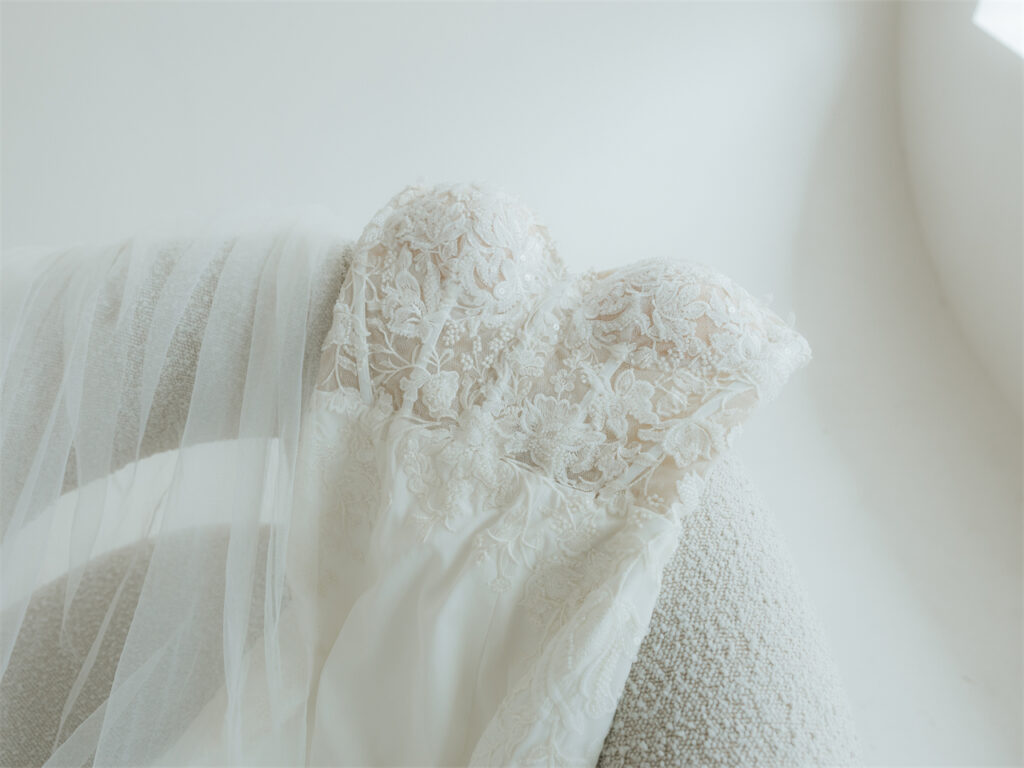
Your wedding gown, which has accompanied you down the aisle and witnessed the exchange of rings and vows, has become more than just an attire but imbued with meaning. It transforms into a cherished memory and a symbol of one of the most significant days of your life. Imagine passing down your pristine gown to the next generation, or simply reliving those beautiful memories every time you see it.
Usually in light color, the wedding dress can easily get stained from eating, drinking, dancing, and outdoor photo shoots after the joyful big day. Worried that a regular dry cleaner won’t handle your wedding dress properly? Or perhaps you want to wash and care for your gown at home but aren’t sure how to do it right? This article will answer all your questions. Here’s a step-by-step guide to help you take care of your precious garment.
In This Article:
- Different Washing Methods for Varied Fabrics
- Guide on Professional Cleaning and Preservation
- Tips on Hand Wash and Preservation by Yourself
- Frequently Asked Questions
Different Washing Methods for Varied Fabrics
Different fabrics require different cleaning methods. Here’s a breakdown of how to handle some common wedding gown materials:
- Silk: Silk is delicate and should be dry-cleaned by a professional. Avoid water and heat, as they can damage the fabric.
- Satin: Satin can be spot-cleaned with a gentle detergent and cold water. For best results, take it to a professional cleaner.
- Lace: Lace is fragile and should be hand-washed with a mild detergent. Lay flat to dry to maintain its shape.
- Tulle: Tulle can usually be hand-washed with mild soap and cold water. Be gentle to avoid tearing.
- Polyester: Polyester is more durable and can often be machine-washed using a gentle cycle with cold water. Check the label for specific instructions.
Guide on Professional Cleaning and Preservation
Choosing a trustworthy dry cleaner can be more challenging than you anticipate. If you ask a dry cleaner if they can handle a wedding dress, I believe ninety percent of them will give you a confident “yes.” However, you should still be cautious, as some may not be familiar with cleaning wedding dresses, especially those with multiple layers, embroidery, beading, and other embellishments. If the shop lacks experience, your dress may never return to its original state. That’s why you need to read the shop’s reviews before making a choice and don’t hesitate to ask the shop how many wedding dresses they have handled and what types they have experience with. Then, you can move on to the following steps:
- Discussing Details: Inform the cleaner about specific stains, fabric types, and embellishments. This will help them choose the appropriate cleaning method.
- Inspection: Before leaving your dress, inspect it together with the cleaner. Point out any areas of concern and discuss how they will handle them.
- Beading and Embellishments: Ensure the cleaner knows how to handle dresses with beading, sequins, or other embellishments. Some solvents can damage these materials, so they may need to be removed and reattached.
- Post-Cleaning Inspection: After cleaning, inspect the dress again to ensure all stains have been removed and the dress is in good condition.
- Preservation: Dry cleaners typically offer several preservation options for your wedding dress, usually involving a hanging garment bag or acid-free tissue wrapping in a white preservation box. It depends on whether you’re looking for short-term or long-term preservation.

Tips on Hand Wash and Preservation by Yourself
Hand washing is a gentle method for certain fabrics like silk, satin, chiffon, organza, and lace. Here’s how to do it:
- Check Fabric Type: Determine the fabric type of your wedding dress. Hand washing is ideal for silk, satin, chiffon, organza, and other delicate fabrics. Avoid hand washing heavily embellished dresses or those with intricate beading.
- Prepare Cleaning Solution: Fill a clean bathtub or large basin with lukewarm water. Add a small amount of mild detergent designed for delicate fabrics.
- Spot Treatment: Before submerging the dress, treat any specific stains with a gentle stain remover. Test the remover on an inconspicuous area first to ensure it doesn’t damage the fabric.
- Submerge Dress: Carefully submerge the dress in the water. Gently agitate the water with your hands to loosen any dirt. Avoid scrubbing or wringing the fabric.
- Soak: Allow the dress to soak for about 30 minutes. This helps to lift any embedded dirt and stains.
- Dry: Dry the dress on a clean towel or hang it on a plastic hanger in a well-ventilated space.
Once your gown is clean, proper preservation is key to maintaining its beauty. Here are some tips:
- Use Acid-Free Materials: Store your gown in an acid-free box or wrap it in acid-free tissue paper to prevent yellowing and fabric degradation.
- Avoid Plastic Bags: Never store your gown in plastic bags, as they can trap moisture and lead to mildew.
- Store in a Cool, Dark Place: Keep the dress in a cool, dark place within your living area, like the top shelf of your everyday closet.
- Avoid Attics and Basements: These areas are prone to temperature fluctuations and humidity, which can damage your gown.

FAQs
Q: What are the Benefits of Wedding Dress Preservation?
A: Preservation keeps your gown looking beautiful, allows you to pass it down as an heirloom, and maintains the memories of your special day.
Q: How Much Does Wedding Dress Preservation Cost?
A: The cost typically ranges from $200 to $500, depending on the fabric, staining, and preservation method.
Q: How Long Does It Take to Preserve Your Wedding Dress?
A: The process can take several weeks, depending on the extent of cleaning required and the preservation method used.
Q: What is the Difference Between Cleaning and Preserving a Wedding Dress?
A: Cleaning removes stains and dirt, while preservation includes additional steps to protect the gown from future damage.
Q: Wedding Dress Preservation Mistakes to Avoid
- Using Plastic Bags: These can trap moisture and cause mildew.
- Storing in Poor Conditions: Avoid attics and basements due to temperature and humidity fluctuations.
- Ignoring Stains: Address stains promptly to prevent them from setting in.



